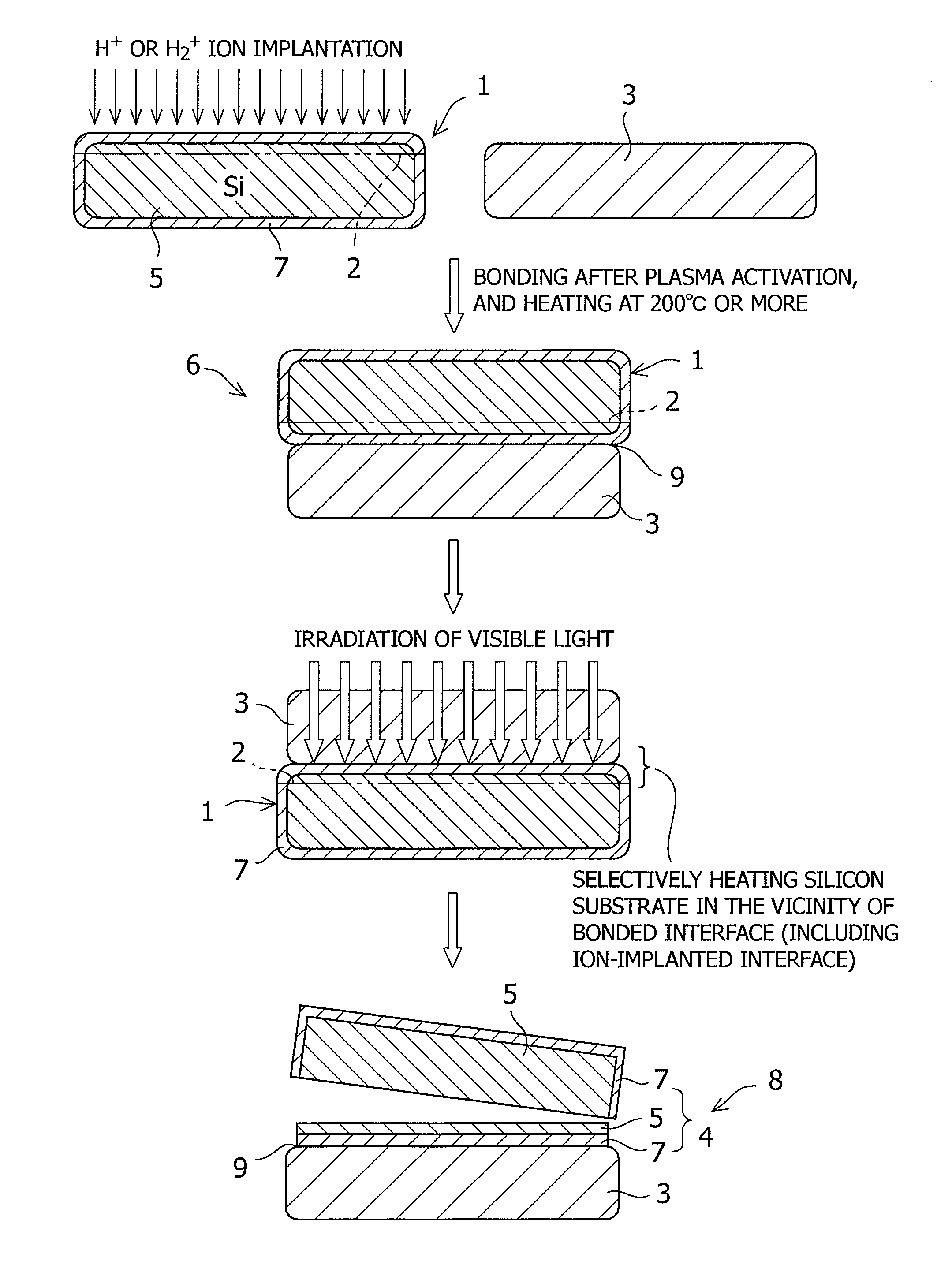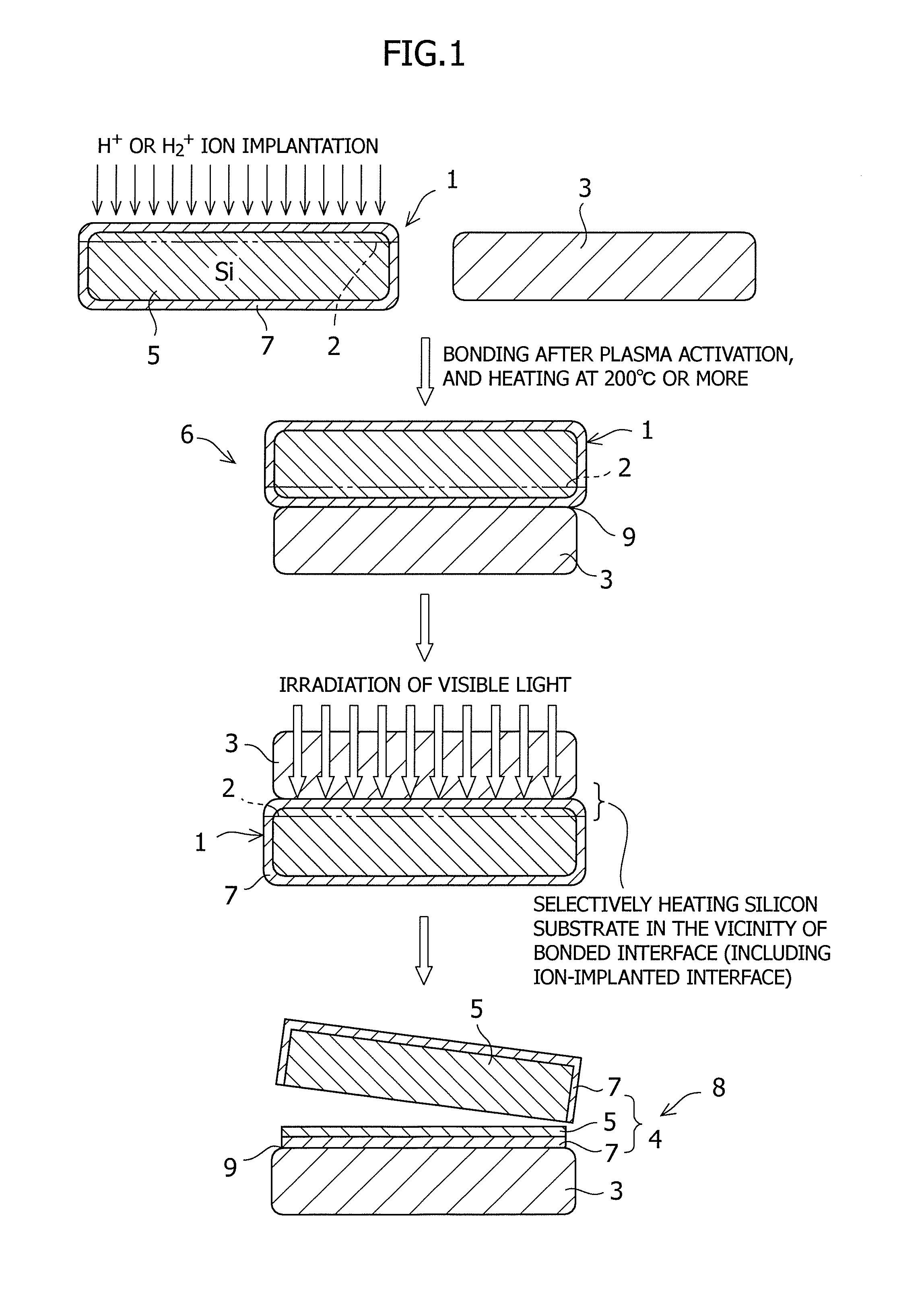Sos substrate having low defect density in the vicinity of interface
- Summary
- Abstract
- Description
- Claims
- Application Information
AI Technical Summary
Benefits of technology
Problems solved by technology
Method used
Image
Examples
example 1
[0072]A silicon substrate (thickness 625 μm) having a diameter of 150 mm on which an oxide film had been grown to 200 nm was subjected to implantation of hydrogen ions at 37 keV and a dose amount of 6.0×1016 atoms / cm2. Both surfaces of a sapphire substrate was subjected to ion beam activation treatment. Then the silicon substrate was bonded to the sapphire substrate at 150° C. After the substrate was subjected to heat treatment at 225° C. for 24 hours for primary bonding, a bonded wafer was heated to 200° C. and irradiated with a green laser having a wavelength of 532 nm from a sapphire substrate side. A laser condition at this time was 20 J / cm2. After the overall surface of the substrate was irradiated, a silicon film was transferred onto the sapphire substrate by splitting along a bonded interface to which a mechanical impact was applied. The transfer of the silicon film onto the overall surface of the substrate could be confirmed. The silicon layer of the substrate was made to a ...
example 2
[0073]A silicon substrate (thickness 625 μm) having a diameter of 150 mm on which an oxide film had been grown to 200 nm was subjected to hydrogen ions at 37 keV and a dose amount of 6.0×1016 atoms / cm2. Both surfaces of a sapphire substrate were subjected to plasma activation treatment. Then the silicon substrate was bonded to the sapphire substrate at 200° C. After the substrate was subjected to heat treatment at 225° C. for 24 hours for primary bonding, light from a xenon flash lamp was irradiated from the sapphire substrate side at 250° C. After the overall surface of the substrate was irradiated, a silicon film was transferred to the sapphire substrate by splitting along a bonded interface to which a mechanical impact was applied. The transfer of the silicon film onto the overall surface of the substrate could be confirmed. When the silicon layer of the substrate was subjected to CPM polishing and made to a thickness of 50 nm. The number of defects of the central part and the ou...
example 3
[0075]A silicon substrate (thickness 625 μm) which having a diameter of 150 mm on which an oxide film had been grown to 200 nm was subjected to implantation of hydrogen ions at 37 keV and a dose amount of 6.0×1016 atoms / cm2. Both surfaces of a sapphire substrate was subjected to UV ozone activation treatment. Then the silicon substrate was bonded to the sapphire substrate at 100° C. After the substrate was subjected to heat treatment at 225° C. for 24 hours for primary bonding, light from a xenon flash lamp was irradiated from the sapphire substrate side at 175° C. After the overall surface of the substrate was irradiated, a silicon film was transferred to the sapphire substrate by splitting along a bonded interface to which a mechanical impact was applied. Cross-sectional TEM (transmission electron microscope) photographs of the substrate were taken at two positions, i.e., at a center and on an outer periphery. No defect was observed at all in a field of view having a narrow TEM le...
PUM
 Login to View More
Login to View More Abstract
Description
Claims
Application Information
 Login to View More
Login to View More - R&D
- Intellectual Property
- Life Sciences
- Materials
- Tech Scout
- Unparalleled Data Quality
- Higher Quality Content
- 60% Fewer Hallucinations
Browse by: Latest US Patents, China's latest patents, Technical Efficacy Thesaurus, Application Domain, Technology Topic, Popular Technical Reports.
© 2025 PatSnap. All rights reserved.Legal|Privacy policy|Modern Slavery Act Transparency Statement|Sitemap|About US| Contact US: help@patsnap.com



